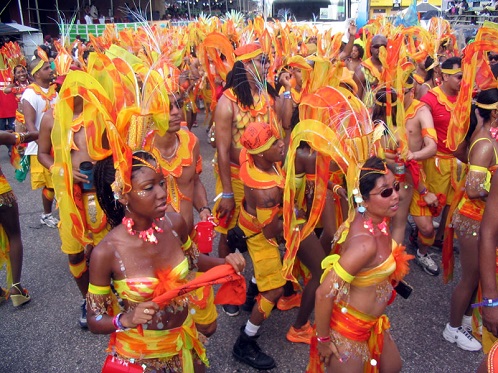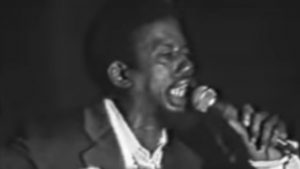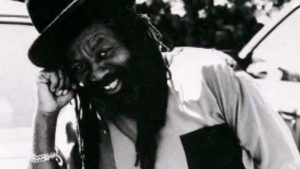I am in Trinidad. It is hot and dry. The roads are crowded. The murder rate is high. The nights are noisy. It is a silly season beyond reason, adequate description and financial sanity. It is Carnival time.

In Trinidad when things go askew, awry or plain arse-over-teakettle, we say “everything turn old mas.” “Mas” is short for “masquerade” but “Old Mas” is what happens on the first or Monday morning of the two-day Carnival. It is when instead of the expensive “cost-umes” masqueraders wear “old” clothes and in the early history of Carnival in the near-dark hours of “foe-day” morning exhibited a lack of decorum, dignity and discipline that was positively anarchistic. One of my earliest Carnival memories came from the days when I lived in the village of Carapichaima in Central Trinidad, a place still known for its “Old Time” Carnival. It was in the half light of dawn that we heard a raucous drum-beating, chanting cacophony that made the dogs go barking mad. My cousin Joe and I rushed outside to see what was causing the noise. I must have been about five at the time. The morning was dusty and out of the murk there was this tight, actually very tight, bunch of massed mas, some with wire masks normally associated with what we called the “Jab Jabs” (Diable, Diable or “Devil, Devil”). The “jab jabs” carried whips and wore costumes like medieval clowns, and masks that always scared the heck out of me – they were sinister and in thinking about it were a kind of a latter-day “V for Vendetta” look. The Jab Jbas jingled as they walked because they wore little anklet bells sewn into their costumes. We called those bells “willows” and I learnt later that they were common to most Eastern countries and that Rajasthani women wore it to show their bravery as a tribe against other rival tribes. This is possibly why Jab-Jabs moved in groups or packs, terrorized spectators sometimes chasing them down for their money, and fought pitched battles in front of the rum shops closest to the village Carnival centre which was the cistern of the railway station. Even in the mists of time, that morning still has texture and tone. Clutching bottles of “puncheon” or overproof rum, some with calabashes (the hollowed out, hardened skin of the bottle gourd which we called “bolee”), men and women came thundering past beating pieces of iron in staccato rhythm shouting “Drink JuC in a calabash”, a popular “lavuey” or chorus at the time. “JuC” was one of the brands of soft drinks– others were “Solo” and “Red Spot”. It really was like something out of hell with the men, their privates on display, proudly aloft so to speak, sweating while Joe and I were shivering, partly from fear, heading noisily down to the Railway Station. Joe looked at me eyes open in wonderment. “Dat real?” he asked. There was a big fight near the cistern that morning. Someone was stabbed. Some of the villagers said that two men from the band were fighting over a woman, most likely a JuC one. From the morning merriment, or even madness, it was clear that everything had turned Old Mas’ or that perhaps Old Mas’ had turned everything. I was recently asked by the Carapichaima businessmen to do a book on the village and returning there brought back memories of those times. What struck me was that there was always an undercurrent of violence- perhaps because the majority of the people worked in the cane-fields, made their living with cutlasses and spent most of their recreation time in the rum shops. It was the way disputes were settled and started. In the midst of all this I got an email from my friend Keith Lequay, a Trinidadian psychologist now living in Jamaica. It featured a drawing of a mosquito perched on a suggestive mound with the words, “It’s only when you see a mosquito landing on your testicles that you realize that there is always a way to solve problems without using violence.” One of my colleagues immediately responded, “That is why women so violent.” I was more concerned about another email that came right after the first. This time Keith sent me a link to a local Trinidad newspaper featuring an article headlined, “Doctor Advocates Eradicating Criminals Like Mosquitoes.” The story is that a medical doctor is proposing that a “dengue approach” to solving crime, could solve the country’s high murder rate and the increasing incidents of rape. According to the article, “Similar to health workers spraying and turning over pots and pans to eradicate mosquitoes in dengue-prone areas, Dr Vijay Bahall last week Thursday told a public forum on crime at the University of the West Indies, that his ‘Medical Surveillance Model’ would weed out criminals and suppress the breeding of young minds to turn to a life of crime, in depressed ‘hotspot’ communities in Trinidad and Tobago.” The problem, as some of my friend pointed out, is that cases of mosquito-borne diseases are rising in the Caribbean and a new one for the region, Chikungunya, is already in St Martin and Dominica. They argue that the approach to mosquitoes is so ineffective that it cannot be used to deal with crime. They say that the only parallel is that both the criminals and mosquitoes are getting tougher. One told me, “The other day I slap a mosquito that was terrorizing me and he slap me back!” *Tony Deyal was last seen asking what do you get if you cross a mosquito with a Jab-Jab? A Mask-quito.












